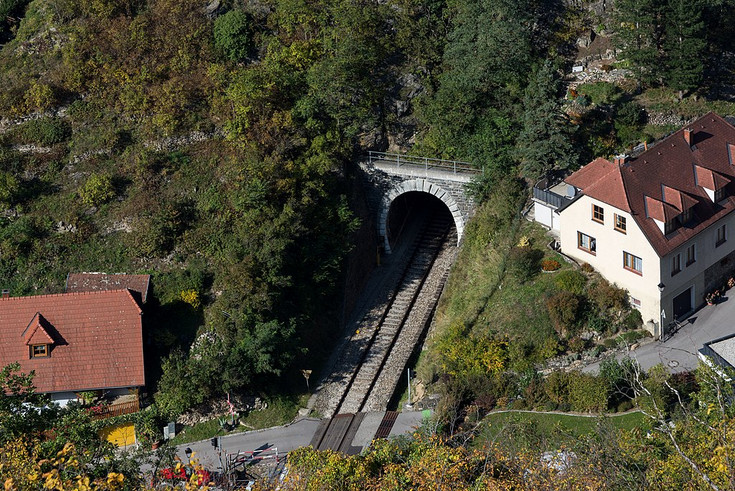30.03.2022 - Wachau Routes: When Landscape Architecture Meets Art
Wachau Routes: When Landscape Architecture Meets Art

Example: The east entrance of the Dürnstein tunnel (c) Wikimedia Commons
The Institute of Landscape Architecture of the University of Natural Resources and Applied Life Sciences Vienna was able to successfully acquire a project with the Institute of Art and Education of the University of Art Linz in the Program for the Development and Exploitation of the Arts (PEEK) of the FWF (Fund for the Promotion of Scientific Research).
After international reviews, "Wachau Routes" was selected by the FWF Board as a funded project. The interdisciplinarity of landscape architecture and art is a particularly enriching cooperation for both universities, which has never existed in this form before.
Since the early nineteenth century, draftsmen and painters have increasingly contributed to highlighting and raising awareness of the scenic beauty of the Wachau. Since then, there has been a continuous artistic engagement with the Austrian region that not only aestheticized it, but also protected it.
The transformation of the landscape was accompanied by a constant expansion of traffic routes. New forms of mobility and speed also changed the way the landscape is perceived. In this process, the traffic routes serve both the use of the inhabitants and the tourist-flanishing view of the guests.
"Wachau Routes" examines a topic of the region that has received little attention so far: the routes through the cultural landscape and the way these routes are seen from different perspectives," emphasizes project manager Roland Tusch from the Institute of Landscape Architecture at BOKU. "The artistic-scientific project provides new insights in perception and aims at the following question: What does a contemporary image of the Wachau look like that builds on art-based methods and corresponds to the contemporary understanding of landscape?"
"Landscape viewing in art often negates modernist or contemporary developments and is romantic and selective, especially in beautiful places," says Hubert Lobnig of the Institute for Art and Education at the University of Art in Linz. "A research project with contextually thinking and acting artists* and landscape architects* includes technical fixtures, misdevelopments, misinterpretations (Nazi period) and oddities in dealing with mass tourism in the investigations and leads - also through unconventional research methods - to a new understanding of the land."
Traffic routes in the spotlight
Until now, the traffic routes through the Wachau have hardly received any attention in artistic works, except in small side scenes, the carriages, transport ships on the Danube or loading scenes in historical paintings. The research project puts the traffic routes in the spotlight and explores them with contemporary methods and concepts of visual art and landscape architecture. Railroads, roads, and bicycle paths are each the focus of the research for one year. Shipping opens perspectives on all three transportation routes studied. The fourth year is dedicated to the synthesis of all investigations. Interdisciplinary collaboration makes it possible to cross borders, adopt new perspectives, expand and develop methods, and acquire skills. The involvement of local users of the transport routes is an essential part of the project.
"Wachau Routes" is funded by the Austrian Science Fund (FWF) Program for the Development and Exploitation of the Arts (PEEK). Project volume: 405,573 euros. Total duration: 4 years (2022-2026). Project start date: summer 2022.
Further information:
https://www.fwf.ac.at/de/news-presse/news/nachricht/nid/20220317?tx_rsmnews_detail%5Bref%5D=l&cHash=0d4cc1e3be5163deedf73d9b50677998
Contact:
Dr. Roland Tusch (Project Management)
University of Natural Resources and Applied Life Sciences Vienna
Institute for Landscape Architecture
roland.tusch@boku.ac.at
Phone: +43 699 19676358
Web: https://boku.ac.at/rali/ila/newsitem/68206
